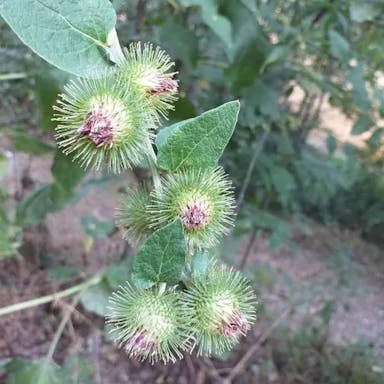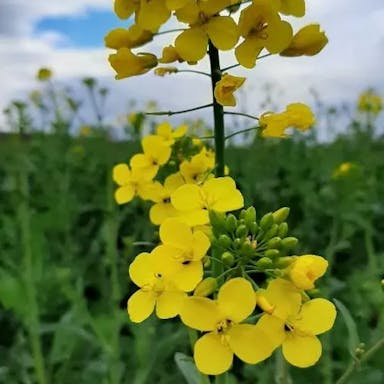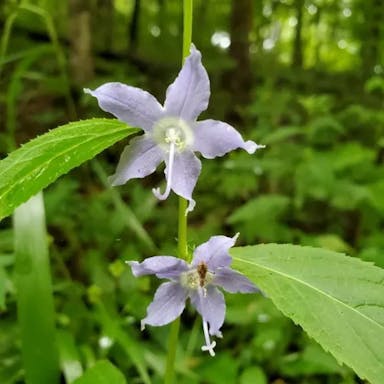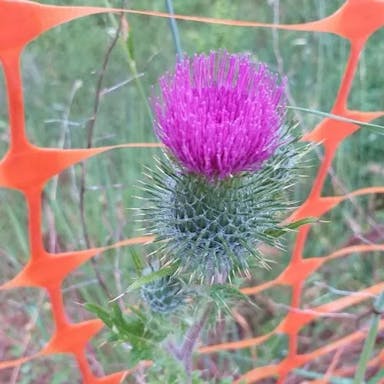Cotton thistle in the United States typically blooms from late spring to early fall. The flowers are at their peak in mid-summer, usually in July and August. Blooming occurs once a year, lasting for about 4-6 weeks. To extend the blooming period, deadhead spent flowers regularly to encourage new blooms. Additionally, providing adequate sunlight, well-drained soil, and regular watering can help promote continuous flowering. Cotton thistle's flowering time in the US is influenced by factors such as temperature and daylight hours. The plant's blooming season may vary slightly depending on the specific region within the country.
Cotton thistle
- Scientific name
- Onopordum acanthium
Basic Information
- Asteraceae Family Onopordum Genus Cotton thistle Species
- Asteraceae > Onopordum > Onopordum acanthium
- 83%
- The Completeness of This Encyclopedia
Please help us complete the encyclopedia, Terrarium is a encyclopedia service to be completed with everyone in the world. Currently, this page is 83% complete. For more information on how to contribute, please click here.
- Biennial
- Forb/herb
- Height
- 200cm ~
- Flower Color
- Leaf Color
- Anthesis
- summer
- Sunlight Exposure
Full Sun Long hours of sunlight from morning to afternoon Partial Shade A location in the shade of a tree or where either the morning or afternoon is shaded Full Shade A place where there is no direct sunlight
- Full Sun
- Hardiness Zones
This is an indicator to know to which zone each plant can winter. Knowing the zone of each plant gives you an idea of the cold temperature resistance when grown in the ground without a roof. 2: -42.7 to -40.0 3: -39.9 to -34.4 4: -34.3 to -28.9 5: -28.8 to -23.3 6: -23.2 to -17.8 7: -17.7 to -12.2 8: -12.1 to -6.7 9: -6.6 to -1.1 10: -1.0 to 4.4 11: 4.5 to 10.0
- 6
- Cold resistance
- Excellent
- Heat resistance
- Fair
- Habitat of origin
- Europe
- Growth Rate
- Normal
What is Cotton thistle (Onopordum acanthium)?
What is Cotton thistle (Onopordum acanthium)
Flower meaning
Cotton thistle offers two main varieties: 1. 'Smooth Cotton Thistle' (C. acanthium var. acanthium) with less spiny leaves and 2. 'Woolly Cotton Thistle' (C. acanthium var. lanigerum) characterized by dense woolly hairs on leaves and stems. When selecting seeds, ensure they are fresh, plump, and free from damage. Opt for seedlings with healthy green leaves and sturdy stems, avoiding any signs of wilting or discoloration. Prioritize varieties based on your garden's conditions; 'Smooth Cotton Thistle' thrives in well-drained soil, while 'Woolly Cotton Thistle' prefers moister environments. Research the specific requirements of each variety for successful cultivation.
Calendar of Cotton thistle (Onopordum acanthium)
Calendar
Cotton thistle can be propagated through seeds, division, and cuttings. Seeds are sown in well-draining soil in early spring or fall, lightly covered, and kept moist until germination. Division involves separating the plant's roots in early spring or fall, ensuring each division has roots and shoots. Cuttings are taken from young shoots in spring or summer, dipped in rooting hormone, and planted in a moist growing medium. Leaf cuttings can also be used by taking a healthy leaf, placing it in a growing medium, and keeping it moist until roots develop. To ensure successful propagation, it is recommended to use a combination of methods to increase the chances of success and produce more plants.
How to grow Cotton thistle (Onopordum acanthium)
Watering
Cotton thistle, scientifically known as Onopordum acanthium, is a biennial plant native to Europe and Asia. It belongs to the Asteraceae family and is characterized by its spiny leaves and stems, which can grow up to 2 meters in height. The plant produces large, purple flower heads surrounded by spiny bracts, adding to its striking appearance. The flowers of Cotton thistle are known for their vibrant purple color, attracting pollinators like bees and butterflies. This plant is considered a noxious weed in some regions due to its aggressive growth habit. It produces small, brown fruits containing seeds that aid in its propagation. Despite its invasive nature, Cotton thistle is valued for its ornamental beauty in gardens and natural landscapes. Cotton thistle is relatively easy to grow in well-drained soil and full sun, making it a popular choice for xeriscaping projects. Its drought tolerance and ability to thrive in various soil types make it a versatile addition to gardens.
Soil and Fertilizer
For the plant Cotton thistle, watering should be done once every 7-10 days during the growing season. Ensure the soil is evenly moist but not waterlogged, allowing the top 1-2 inches to dry out between waterings. During the dormant period, reduce watering to once every 2-3 weeks to prevent root rot. Adjust watering frequency based on environmental conditions such as temperature and humidity. Avoid overhead watering to prevent fungal diseases and focus on watering the base of the plant. Monitor soil moisture regularly by inserting a finger into the soil to determine if watering is needed.
Sunlight and Place
The flower language commonly used in America for the Cotton thistle is: - Defiance - Independence - Resilience One typical example is "Defiance," symbolizing the plant's ability to thrive in harsh conditions despite adversity, reflecting strength and determination.
Advanced Information of Cotton thistle (Onopordum acanthium)
Pruning
Cotton thistle thrives in full sun exposure, requiring at least 6 hours of direct sunlight daily. It exhibits excellent heat tolerance, making it suitable for warm climates. Cold tolerance is moderate, with the plant being able to withstand mild frosts. During winter, it is advisable to provide protection or bring indoors in regions with harsh winters. The optimum temperature for Cotton thistle ranges between 60-75°F (15-24°C). It is essential to avoid extreme temperature fluctuations to maintain plant health. Over summer, ensure adequate watering and mulching to retain moisture. During winter, reduce watering frequency to prevent root rot. Placing Cotton thistle in well-draining soil and providing sufficient sunlight will promote healthy growth. It is recommended to avoid overwatering and ensure good air circulation around the plant.
Planting and Harvest
Cotton thistle thrives in well-drained soil with a pH level between 6.0 and 7.5. It prefers sandy or loamy soil that is rich in organic matter. Fertilize cotton thistle in early spring with a balanced fertilizer, such as a 10-10-10 formula, to promote healthy growth. Apply fertilizer again in mid-summer to support blooming. Use approximately 1 pound of fertilizer per 100 square feet of soil. Avoid over-fertilizing as it can lead to excessive foliage growth at the expense of flowers. Regularly check the soil quality to ensure it remains fertile and well-drained for optimal cotton thistle growth.
Propagation
Cotton thistle benefits from regular pruning to maintain its shape, promote new growth, and prevent overcrowding. Pruning should be done in late winter or early spring before new growth emerges. Remove dead or damaged stems by cutting them back to the base of the plant. After pruning, dispose of the cuttings properly to prevent the spread of diseases.
Pests and Diseases
Cotton thistle is best potted in well-draining soil with a pH of 6.0-7.5. Ensure the pot has drainage holes to prevent waterlogging, and place it in a sunny location. When planting, sow seeds 1/8 inch deep and keep the soil consistently moist until germination. For repotting, choose a slightly larger pot and refresh the soil every 2-3 years. Mist the plant occasionally to increase humidity, and fertilize sparingly during the growing season. If the plant becomes leggy, pinch back the stems to encourage bushier growth.
Habitat of Cotton thistle (Onopordum acanthium)
Habitat
Toxicity of Cotton thistle (Onopordum acanthium)
Health Benefits
- edible
- Inedible
- Toxic
- No toxicity
NO DATA
Toxic for dogs and cats
NO DATA
Q&A of Cotton thistle (Onopordum acanthium)
- Is there a recommended way to choose Cotton thistle?
Cotton thistle is susceptible to various pests and diseases, including aphids, spider mites, and powdery mildew. These pests can weaken the plant by sucking sap or causing damage to the leaves, leading to stunted growth and reduced vigor. Aphids are small insects that feed on plant sap, causing yellowing and distortion of leaves. Spider mites are tiny arachnids that suck sap from the plant, causing stippling and webbing on the leaves. Powdery mildew is a fungal disease that appears as a white powdery substance on the leaves, inhibiting photosynthesis and nutrient uptake. To prevent these issues, maintaining good plant hygiene, providing adequate air circulation, and avoiding overcrowding can help reduce the risk of infestation. Regularly inspecting the plant for early signs of pests or diseases and promptly treating them with appropriate measures can also help in preventing severe damage.
0
0











